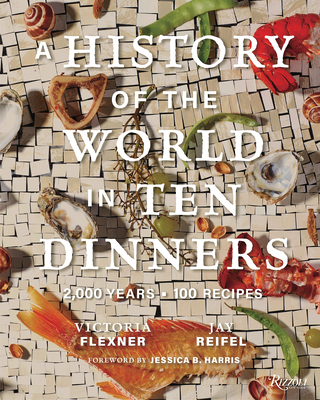A
Genre: Cookbook, Nonfiction
If you are a history buff, a food buff or (ideally) both, then you have to read A History of the World in Ten Dinners: 2000 Years, 100 Recipes. This book is so well-organized and natural that I’m not sure if I should say that it’s a food book with history or a history book with food.
I was this many days old when I learned about Edible History. Victoria Flexner and Jay Reifel host historically themed dinners as well as other culinary projects. They are listed as co-authors of A History of the World in Ten Dinners but throughout the book the author is referred to as a singular, and ever-present, and relatable, figure.
This is a sumptuous coffee-table sized book about historical food with recipes adapted for modern use. The photography is gorgeous, the writing is powerful, the history is riveting. The authors work to incorporate various parts of the world while being transparent about their limitations: the earliest cookbooks that we still have access to were generally written about food for the elite and for and by men. This is not a book that tells you how to make the stew a Roman laborer might have eaten for lunch. It’s a book that tells you how to make The Cockenthrice, which is the front half of a suckling pig roasted, stuffed, and tied to the (also roasted and stuffed) back end of a chicken, including feet.

I don’t normally just up and post the table of contents, but in this case I think it will be helpful for the prospective reader to see what’s involved. The book starts in First Century Ancient Rome, then goes to:
- Baghdad: Eighth to Thirteenth Centuries
- The Silk Road: Thirteenth to Sixteenth Centuries
- Renaissance Italy: Fourteenth to Sixteenth Centuries
- Tudor England: Fifteenth to Seventeenth Centuries
- Al-Andulas: Eighth to Fifteenth Centuries
- The Great Circulation: Fifteenth to Seventeenth Centuries (this era is known elsewhere as the Columbian Expansion – I prefer the authors’ label).
- Ethiopia: Thirteenth to Nineteenth Centuries
- Versailles: Seventeenth to Eighteenth Centuries
- New York City: Nineteenth Century
You can see that there is overlap here and a lot of what the authors do is show what ingredients turned up where, and when, and why. The authors discuss lost ingredients and how they work around them, and why their recipes include use of modern tools such as a food processor. In that case, the food would previously have been ground by hand, probably by a child servant or an enslaved child. Using the anachronistic food processor seems a better option.

One thing I CAN’T evaluate is how easy the recipes are to follow and how well they turn out. I consider it a triumph of the human spirit when I summon the energy to scramble eggs. I’m not going to make Glazed Whore’s Farts no matter how much the name fills my heart with bliss (they are meringues from Versaille, and no actual farts are involved). However, the recipes are clearly written, there are suggestions of how to procure unusual cuts of meat or ingredients, there are gorgeous full color pictures, and they look pretty easy to follow if not always easy to carry out. I’m optimistic that an adventurous cook would be able to actually cook from this cookbook. Perhaps some of you in the comments will try it out and report back.
What I can tell you is that I learned a great deal from this book, especially about An-Andulas and Ethiopia as well as patterns that seem to occur in the fall and rise of empires. I thoroughly enjoyed reading the book and the recipes as entertainment as well as education. While my library copy was spotless and glossy, I can guarantee that, if I purchase this, it will shortly be covered with the flour and butter stains of enthusiastic use – and what greater praise for a cookbook can there be?
This book is available from:
As an Amazon Associate we earn from qualifying purchases.
We also may use affiliate links in our posts, as well.
Thanks!



The libraries here don’t have this yet, but I am going to suggest a purchase, and keep checking for it. This sounds amazing, both for the food and the history.
Oh, this sounds super interesting!
This sounds very fancy. Placed a hold at the library, just to flip through and see if there is anything my vegetarian self can eat without altering the recipes.